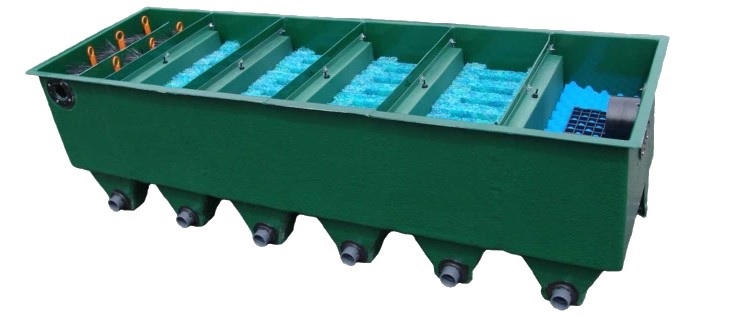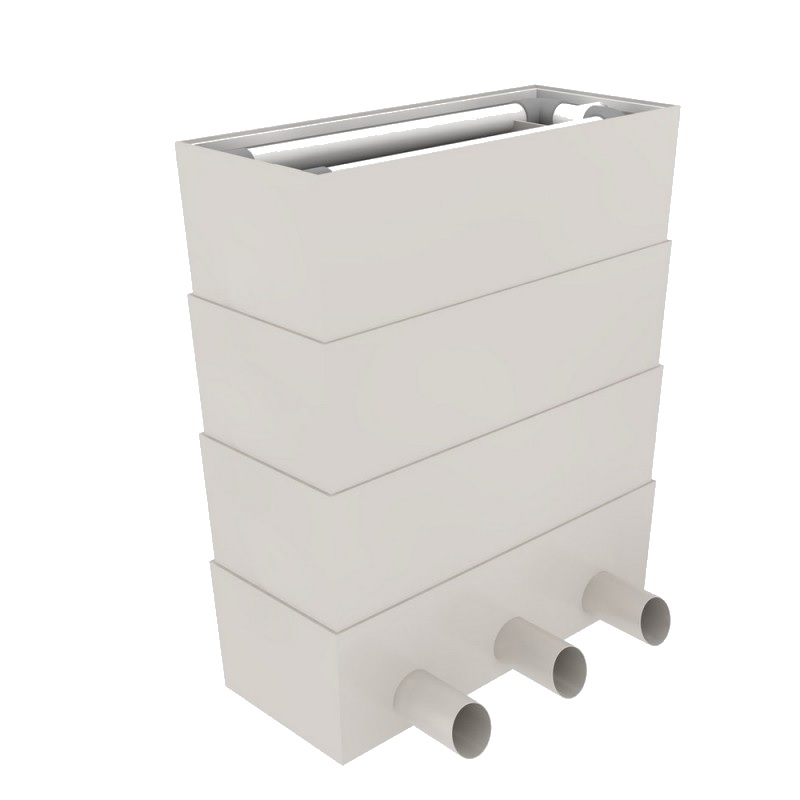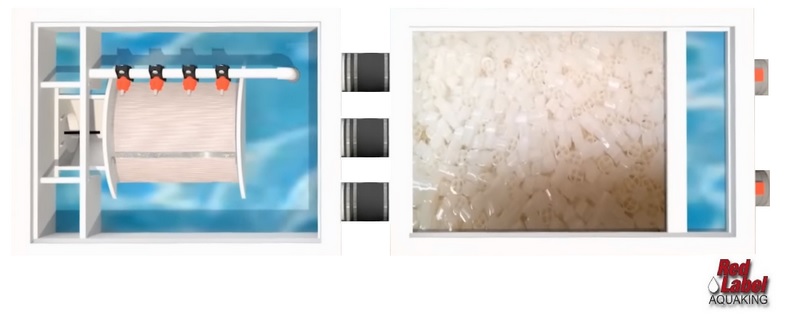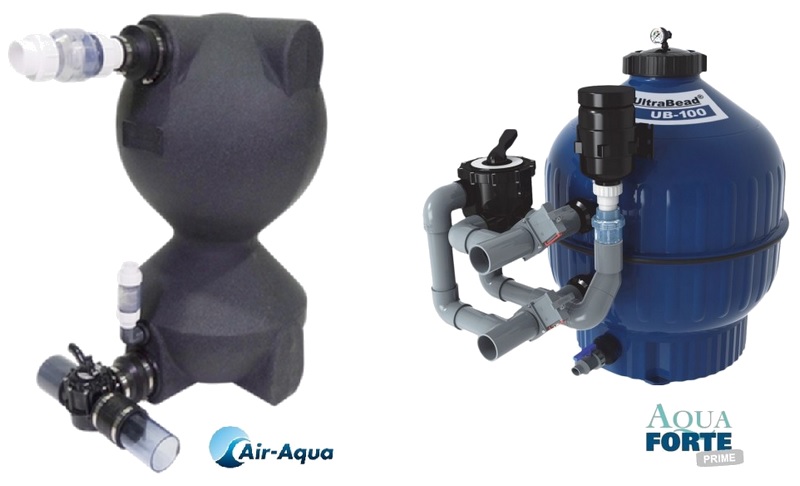-
 Français
Français
-
 English
English
No products
Prices are tax included
Why biological filtration?
To answer this question completely, we would need to address the question of the nitrogen cycle. You can consult the “water chemistry” section on this site where you will read a page dedicated to this subject (highly recommended)...
In this practical section, we will simply say that as Koi (or other fish) find proteins in their diet, and these proteins contain amino acids, the waste produced by Koi contains ammonia. This toxic agent is evacuated mainly through the gills and without biological filtration, ammonia would reach a fatal concentration for Koi. Biological filtration therefore consists of “using” good bacteria to transform ammonia into other less toxic nitrogen waste (> nitrites > nitrates).
The multi-chamber filte
This is the most used type of filter, the most popular because it allows all configurations and can be suitable for almost all ponds. It is found in many variations and in many sizes.
The materials that make up the quality of a filter are composites (polyester) and polypropylene (PP or PE).
“Plastic” materials are often more fragile and it is therefore necessary to take all guarantees when opting for this material. Stainless steel or PP filters are very robust but more expensive.
The filter can be one-piece with compartments arranged in a line, or assembled around a central vortex: there are also separate modules which, once joined together, also form a multi-chamber filter.
Usually, a multi-chamber filter includes mechanical filtration followed by a series of compartments intended for the biological part. Depending on the location or preferences, the filter may or may not integrate a vortex; for small basins with a modest pumping rate, this may prove interesting; however, for larger basins, the size of the vortices is often too small and the efficiency remains uncertain.
In this case, it is better to combine a grid pre-filter with a classic multi-chamber filter or opt for another mechanical filtration system. In all cases, after the vortex follows one or more compartments filled with brushes.
Concerning the volume of these filters, it must unfortunately be noted that many manufacturers do not hesitate to overestimate the performance of their systems: we must therefore avoid taking the indications as an absolute reference and remember that a filter is never too big.
Below is an example of a multi-chamber filter including one chamber with brushes and five biological chambers with Japanese carpets. To pass from one chamber to another, the water must pass through Up-Flow, which means that the water enters each chamber from below. The direction of water flow is therefore upward in all the rooms. A discharge valve is also provided for all compartments.
For half a dozen years, it must be noted that interest in this type of filtration has clearly declined in favor of drum Combi, which are more efficient and require much less maintenance. The supply has also fallen considerably and today we can only find 10 to 15% of the existing supply a few years ago.

The semi-wet or trickle filter
Following various marketing operations, the "original" semi-wet filter, which has existed for more than thirty years, has many different names, but the operation remains the same: the substrates are placed in containers arranged in tiers and the water trickles onto the filter masses.
It is a very simple principle which has the disadvantage of consuming more energy, taking up space on a vertical plane and it is therefore not always very easy to camouflage. It is also a source of noise and by its design, it evaporates a lot of water: in certain applications, however, it remains an excellent filtration system.
It is therefore a typically biological filter that must be associated with mechanical filtration: nitrification produces sediments and even if some use it independently (breeding farms, fish farms which throw away the supports regularly after clogging), in ornamental pond it is essential to combine it with good pre-filtration. A variant exists in the form of a closed cylindrical tank which must be supplied with air.
All these trickle filters provide oxygenation and depending on the type of support, the performance ranges from good to very good. Finally, depending on the importance of the organic load, scum can form at the foot of these filters and a retention tank must therefore be provided to prevent the scum from reaching the pool. Bioballs can be used as media, as can certain low-porosity ceramics to avoid too rapid clogging.
Specialists will prefer media such as Bacteria Home or Bacteria House, or even glass foam whose porosity is extreme... These media make the trickle filter terribly effective.

The fluidized filter, moving bed
Initially, the principle was based on the upward passage of the water to be treated through a bed of sand. The sand is kept in suspension simply by the flow of this water to be treated.
If the sand used contains particles of 0.1 to 1mm, the colonization surface for bacteria can easily reach 40,000m²/m³: this is the record held by this type of filter!
Experimented in certain wastewater treatment plants (pilot plants in the USA, Canada and also in Europe), this process has produced excellent results. Likewise in aquariums, the system has been used in various variants: nitrification, reduction of phosphates with oxide beads... always with the same success.
On the other hand, in Koi ponds, this type of fluidized filter is very rarely used because it is too capricious: the slightest variation in flow rate modifies the speed in the reactor and in this case, the fluidized bed can collapse in the filter and become useless. .
Given this major flaw, the principle was modified, the moving bed was born!
Instead of using the flow of water to suspend media, an aeration device sets Hel-X type media in motion. The filter, made up of a good-sized tank, is simply passed through by the water to be treated. The diffusers create a convection movement, the media are therefore continually moving and are held in the filter by large strainers.
The current trend combining drum filter and moving bed makes it possible to considerably reduce the size of the filters: this advantage combined with the fact that the system is self-cleaning, this type of filter has now become a must. Another process combining the moving bed and a bedroom with Japanese carpet is also very popular because it offers a more interesting dynamic. In the event of a failure of the bacterial flora, for example following a treatment, there is a faster and clearer start of biological filtration.

Bead filters
Beads are small polypropylene beads serving as a support for nitrifying bacteria: after sand, this media is the one with the best surface/volume ratio, since a cubic meter of beads represents approximately 1350 m² of surface area.
The filter, whose tank has the same constitution as that of a sand filter, is powered by a pump: the water passes through a bed of substrate, from bottom to top, which is mainly located in the upper part of the tank .
The density of the beads is less than 1 and as a result they form a thick static mattress which remains suspended in the filter and which traps the smallest particles. This type of filter is both a good mechanical and biological filter!
The supply and discharge ports are fitted with strainers which prevent the pearls from coming out with the purified water. It is advisable to provide at least one grid pre-filter with this bead filter, otherwise it will cause clogging and/or maintenance which will harm the biology of the filter.
With an identical operating principle, many brands offer these bead filters in various variants: some have multi-way valves, air pumps... while others simply consist of a reservoir... The beads are also available in countless variations (shapes, dimensions, materials, etc.)
Widely used in Anglo-Saxon countries, the bead filter can be sufficient in itself: however, given its slowness to react at the biological level, it is sometimes preferable to combine it with a second biological filter. It forms a perfect duo if it is assisted by a complement of Japanese mats: thus, at the start of the season, or following a treatment, the bacteria develop very well in the mats, which compensates for the delay of the bead filter which always requires a little more time.
Note that if the bead filter allows both mechanical and biological filtration, it is essential to supply it with water which will be pre-filtered and well oxygenated (grid or drum pre-filter) otherwise it will quickly become clogged. and cause a series of big problems. This is typically good equipment which unfortunately is often used very poorly….

Miscellaneous
The description of the different biological filtration processes ends here, however there are other filters on the market.
Barrel filters: these small, inexpensive containers filled with plastic media or stones are not suitable for ponds. Too small, poorly oxygenated, they cannot purify a pond on their own. The most elaborate can ultimately be used to filter a small preformed 500 liter pond or a quarantine tank, without more...
Moss filters: even if moss is an excellent bacterial support, these filters should be avoided in Koi ponds because they clog very (too) quickly in the pond. Having experienced numerous processes (pressure filters - high pressure foam) I can conclude that these make it possible to obtain very clear water but only for goldfish ponds with a maximum capacity of 10 m3.
If this is your case, opt for a brand filter which now offers solid products that are easy to maintain and equipped with powerful UVC lamps. Oase being the leader in this product, the FiltoClear model can be perfect for these small pools. The advantage being that the water outlet being under pressure, it is possible to animate a small waterfall or a blade of water, with the filtration pump alone.

In summary
In biological filtration, filters come in three categories, the first of which includes static submerged bacterial cultures, the second, watered substrates and finally, fluidized systems. All three categories are very capable and each offers advantages and disadvantages.
The first, the most classic with Japanese rugs, has been proven for decades but requires a little more space. The response to bacterial growth is unmatched.
Runoff filters are undoubtedly the most effective but cause noise pollution and can contribute to amplifying variations in pool water temperature.
Moving beds are very efficient and should continue to evolve: performance is significantly better, the devices are less bulky and maintenance is easier.
But the weak point of this filtration is only based on a single type of media, which is quite slow to be colonized, so these are filters that should ideally be combined with another device.
Without this drawback and preceded by good mechanical filtration (drum or sieve filter), the moving bed is an excellent biological purifier.
INTELLECTUAL PROPERTY
It is strictly prohibited to reproduce any content or element from the bassin-baignade.eu site without having first obtained the express written authorization of Naïades. All elements such as texts, photos, videos, images, diagrams and other data appearing on the site are protected by intellectual rights belonging to Naïades. Without the prior written consent of Naïades, it is prohibited to use, reproduce, modify, publish, distribute, send or sell any of the elements on this page.
![]() 2024
2024
